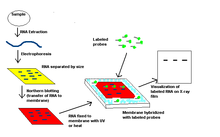A restriction enzyme (or restriction endonuclease) is an enzyme that cuts double-stranded or single stranded DNA at specific recognition nucleotide sequences known as restriction sites. Such enzymes, found in bacteria and archaea, are thought to have evolved to provide a defense mechanism against invading viruses. Inside a bacterial host, the restriction enzymes selectively cut up foreign DNA in a process called restriction; host DNA is methylated by a modification enzyme (a methylase) to protect it from the restriction enzyme’s activity. Collectively, these two processes form the restriction modification system. To cut the DNA, a restriction enzyme makes two incisions, once through each sugar-phosphate backbone (i.e. each strand) of the DNA double helix.
After isolating the first restriction enzyme, HindII, in 1970
, and the subsequent discovery and characterization of numerous restriction endonucleases,
the 1978
Nobel Prize for Physiology or Medicine was awarded to Daniel Nathans, Werner Arber, and Hamilton O. Smith.
Their discovery led to the development of recombinant DNA technology that allowed, for example, the large scale production of human insulin for
diabetics using
E. coli bacteria.
Over 3000 restriction enzymes have been studied in detail, and more than 600 of these are available commercially
and are routinely used for DNA modification and manipulation in laboratories


